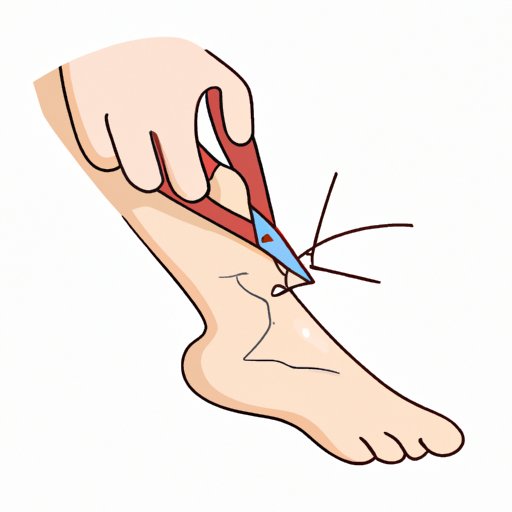
Introduction
Ingrown hairs are a common problem for people who shave or wax, and they can be both painful and unsightly. Fortunately, there are many effective ways to get an ingrown hair out and prevent them from occurring in the first place. In this article, we’ll explore various home remedies, prevention tips, professional treatments, and more to help you deal with this frustrating issue.
Home Remedies
Home remedies can be an effective and inexpensive way to treat ingrown hairs. When using home remedies, it’s important to choose gentle and natural ingredients that won’t irritate the skin further. Here are a few home remedies to consider:
– Warm compresses: Applying a warm compress to the affected area can help reduce inflammation and promote healing. Simply soak a washcloth in warm water, wring it out, and apply it to the affected area for several minutes at a time.
– Tea tree oil: Tea tree oil has anti-inflammatory and antimicrobial properties that can help soothe the skin and prevent infection. Mix a few drops of tea tree oil with a carrier oil, such as coconut or olive oil, and apply it to the affected area.
– Sugar scrubs: Exfoliating the skin can help remove dead skin cells and prevent ingrown hairs from forming. Mix sugar with olive oil or honey to make a gentle exfoliating scrub, and use it to massage the affected area in circular motions.
Prevention Tips
Preventing ingrown hairs is often easier than treating them once they’ve formed. Here are a few tips to consider:
– Exfoliate regularly: Exfoliating the skin can help remove dead skin cells and prevent hair from becoming trapped under the surface. Use a gentle exfoliating scrub or a loofah to exfoliate the skin regularly.
– Use a sharp razor: Dull razors can cause ingrown hairs by pulling the hair instead of cutting it cleanly. Use a sharp razor, and replace your razor blades frequently to prevent irritation.
– Avoid tight clothing: Wearing tight clothing can cause friction and irritation, which can lead to ingrown hairs. Choose loose-fitting clothing made from breathable materials, such as cotton.
Step-by-Step Guide
If you do develop an ingrown hair, it’s important to remove it safely and effectively to avoid further irritation. Here’s a step-by-step guide:
1. Sterilize a pair of tweezers by soaking them in rubbing alcohol for several minutes.
2. Gently lift the tip of the hair using the sterilized tweezers.
3. If the hair is visible and close to the surface, carefully remove it by pulling it out in the same direction it’s growing.
4. If the hair is not visible or is too deep to reach with tweezers, do not attempt to remove it. This can lead to further irritation or infection.
5. After removing the hair, apply a warm compress to the affected area to help reduce inflammation.
Professional Treatments
For stubborn or recurrent ingrown hairs, professional treatments may be necessary. Here are a few options to consider:
– Laser hair removal: Laser hair removal can be an effective way to permanently reduce hair growth and prevent ingrown hairs from forming.
– Chemical peels: Chemical peels can help exfoliate the skin and prevent ingrown hairs from forming.
If you’re interested in professional treatments, be sure to do your research and find a reputable provider who has experience treating ingrown hairs.
How to Treat Infected Ingrown Hairs
Sometimes, ingrown hairs can become infected, causing redness, swelling, and pus. If you suspect you have an infected ingrown hair, it’s important to seek medical attention. In the meantime, here are a few tips to consider:
– Avoid picking at the infected area, as this can spread the infection.
– Apply an antibiotic ointment to the affected area to help prevent further infection.
– Use warm compresses to reduce inflammation and promote healing.
Differences Based on Body Part
The treatment of ingrown hairs can vary depending on where they occur on the body. For example, ingrown hairs on the face may require more gentle treatment than those on the legs. Be sure to adapt your treatment approach based on the location of the ingrown hair.
Timeframe for Healing
It can take several days to several weeks for an ingrown hair to heal, depending on the severity of the condition. During this time, it’s normal to experience some discomfort or scarring. However, if your symptoms persist or worsen, it may be necessary to seek medical attention.
Conclusion
Ingrown hairs can be a frustrating and uncomfortable problem, but there are many effective ways to prevent and treat them. From home remedies to professional treatments, the key is to find the approach that works best for you. By following the tips in this article, you can get an ingrown hair out safely and effectively, and hopefully prevent them from occurring in the future.




